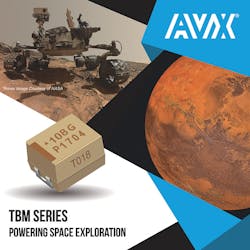Capacitors Guide Laser Module to More Knowledge About Mars
It’s only appropriate that space-level tantalum capacitors from AVX Corp. should help shed some light on the craters of Mars. The 630 space-level SRC9000 TBM Series capacitors have been powering the ChemCam laser module on NASA’s Curiosity rover (the Mars Science Laboratory) for many new observations about Mars—for almost 2100 sols, or Martian days—since landing in the Gale Crater in 2012.
The capacitors in the laser module form part of a photographic system that is helping to study whether the Martian environment has ever supported microbiological life. By now, the capacitors have supported more than half-a-million firings of the laser, which is used to illuminate the surroundings in the vicinity of the Curiosity for photography. The laser is also used to clear dust away from Martial rocks so that the ChemCam’s remote camera can acquire detailed images of its surroundings.
TMB Series tantalum capacitors have been part of a laser-driven photography system on NASA’s Curiosity Rover vehicle exploring the planet Mars.
The electronic components within the Curiosity and the ChemCam, including those capacitors, have proven to be highly reliable and capable of providing dependable performance, even under hostile operating conditions.
“The continued success of the ChemCam demonstrates the long-term reliability of our MnO2-cathode TBM Series multianode tantalum capacitors,” said Brian Brunette, assistant quality and reliability manager for AVX’s tantalum division, “and further supports the proven reliability of our rigorous SRC9000 space-level qualification and inspection process, which was developed especially for long-term, mission-critical applications, and in addition to the ChemCam, is used extensively on satellite programs.
“AVX is the world’s largest manufacturer of the high-reliability tantalum capacitors employed in mission-critical and aerospace electronics, life-sustaining and implantable FDA Class III medical devices, and space-constrained, harsh environment, safety-critical automotive electronics, including advanced driver assistance systems (ADAS),” Brunette continued.
About the Author
Jack Browne
Technical Contributor
Jack Browne, Technical Contributor, has worked in technical publishing for over 30 years. He managed the content and production of three technical journals while at the American Institute of Physics, including Medical Physics and the Journal of Vacuum Science & Technology. He has been a Publisher and Editor for Penton Media, started the firm’s Wireless Symposium & Exhibition trade show in 1993, and currently serves as Technical Contributor for that company's Microwaves & RF magazine. Browne, who holds a BS in Mathematics from City College of New York and BA degrees in English and Philosophy from Fordham University, is a member of the IEEE.


